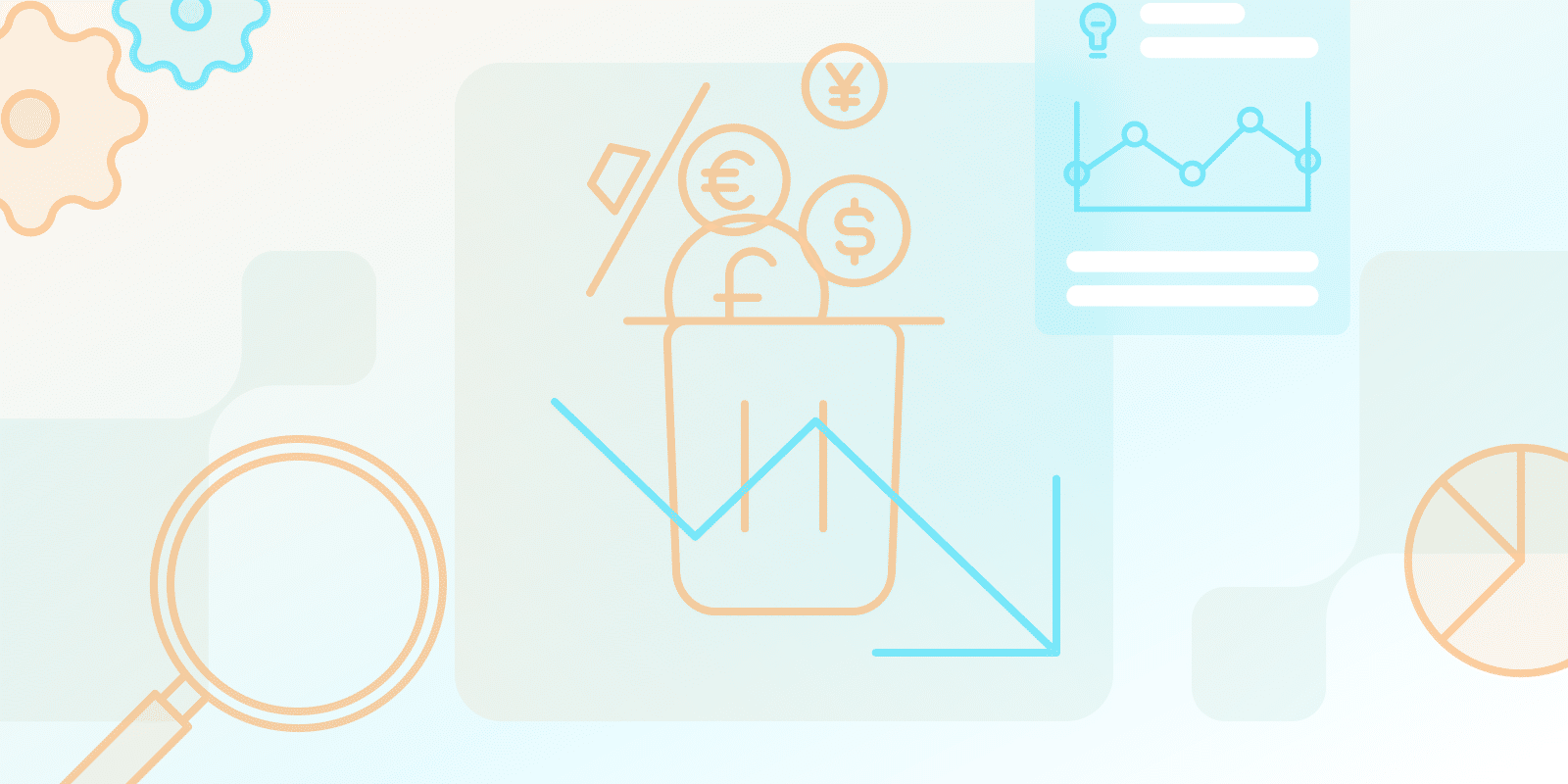SaaS-Zahlungen
Was sind SaaS-Umsatzverluste?
Veröffentlicht: 1. August 2025

Was sind SaaS-Umsatzverluste?
SaaS-Umsatzverlust ist die Differenz zwischen dem prognostizierten wiederkehrenden Umsatz und dem tatsächlichen Umsatz, möglicherweise beeinflusst durch Rechnungsfehler, Missmanagement von Abonnements oder erfolglose Zahlungseinzüge.
Dieser entgangene Umsatz bleibt häufig unbemerkt, kann aber erhebliche Auswirkungen auf die Rentabilität und die Finanzprognosen von SaaS-Unternehmen haben, wenn er nicht umgehend behoben wird.
Welche verschiedenen Arten von SaaS-Umsatzverlusten gibt es?
Umsatzverluste in SaaS-Unternehmen können aus einer Vielzahl von Quellen stammen, von denen viele in Abrechnungssystemen, CRM und Produktnutzungsprotokollen verborgen sind.
Häufige Arten sind:
- Abrechnungsfehler: Rechnungen können mit falschen Beträgen oder gar nicht verschickt werden.
- Nicht abgerechnete Nutzung: Kunden überschreiten ihre Nutzungsbeschränkungen, aber der Überschuss wird nicht überwacht oder berechnet.
- Fehlgeschlagene Verlängerungen: Abonnementsverlängerungen schlagen aufgrund ungültiger Karten oder Systemproblemen fehl.
- Überschreitung kostenloser Testphasen: Benutzer nutzen das Produkt nach Ablauf des kostenlosen Testzeitraums weiter, ohne auf einen kostenpflichtigen Plan zu wechseln.
- Rabattmissbrauch: Nicht genehmigte Rabatte oder individuelle Preise, die nicht ordnungsgemäß dokumentiert wurden.
- Manuelle Prozesse: Menschliche Fehler bei der Rechnungsstellung, Aktualisierungen oder Verlängerungen treten aufgrund mangelnder Automatisierung auf.
Jedes dieser Szenarien kann die monatlich wiederkehrenden Umsätze (MRR) und die jährlich wiederkehrenden Umsätze (ARR) im Laufe der Zeit reduzieren.
Was sind die wichtigsten Schritte zur effektiven Erkennung von SaaS-Umsatzverlusten?
Das Erkennen von Umsatzeinbußen erfordert eine Kombination aus automatischer Überwachung und regelmäßigen manuellen Prüfungen.
Schlüsselschritte:
- CRM- und Abrechnungsdaten vergleichen: Stellen Sie sicher, dass die Abonnementbedingungen in den Vertriebs- und Abrechnungssystemen konsistent sind.
- Rechnungen prüfen: Vergleichen Sie Rechnungen mit Nutzungsdaten und prognostizierten Abrechnungsbedingungen.
- Behalten Sie den Überblick über fehlgeschlagene Zahlungen, einschließlich Ablehnungen, Mahnversuchen und abgelaufener Karten.
- Test-zu-Zahlungskonvertierungen analysieren: Stellen Sie sicher, dass Testversionen korrekt konvertiert werden und rechtzeitig ablaufen.
- Verwenden Sie Umsatzintelligenz-Tools: Tools wie ChartMogul und SaaSOptics können Ihnen helfen, Unregelmäßigkeiten zu identifizieren.
Diese Verfahren helfen festzustellen, wo Umsatzeinbußen entstehen, und ermöglichen proaktives Eingreifen.
Wie berechne ich SaaS-Umsatzverluste?
Sie können SaaS-Umsatzverluste berechnen, indem Sie die erwarteten Einnahmen mit den tatsächlich eingenommenen Einnahmen in einem bestimmten Zeitraum vergleichen.
Formel:
Umsatzverlust (%) = [(Erwartete Einnahmen - Erfasste Einnahmen) ÷ Erwartete Einnahmen] × 100
Die monatliche oder vierteljährliche Verfolgung ermöglicht es Ihnen, Muster zu erkennen und langfristige Verluste zu reduzieren.
Wenn Sie 100.000 $ Umsatz erwartet, aber 95.000 $ eingenommen haben:
(100.000 – 95.000) ÷ 100.000 = 0,05 → 5 % Verlust
Was sind die effektivsten Strategien zur Minimierung von SaaS-Umsatzverlusten?
Umsatzverluste können durch Automatisierung, bessere Kontrollen und ständige Überwachung reduziert werden.
Praktische Strategien:
- Abrechnungssysteme automatisieren: Reduzieren Sie manuelle Fehler.
- Intelligentes Mahnwesen implementieren: Aktivierung automatischer Zahlungsversuche und Benutzerwarnungen.
- CRM-Billing-Integration verbessern: Sicherstellen, dass Kundendatensätze und Abonnementdaten synchronisiert sind.
- Rabattrichtlinien durchsetzen: Rabattberechtigungen einschränken und Genehmigungskriterien festlegen.
- Änderungen von Abonnements überwachen: Analysieren Sie diese, sobald sie auftreten, z. B. Upgrades, Downgrades, Pausen und Kündigungen.
Diese Faktoren beeinflussen zusammen die Wahrscheinlichkeit nicht abgerechneter Gebühren und die Gross Revenue Retention (GRR).
Wie hilft Technologie speziell SaaS-Unternehmen, Umsatzeinbußen zu verhindern?
Technologie trägt zur Vermeidung von Verlusten durch Aufgabenautomatisierung und Transparenzfunktionen bei.
Hilfreiche Technologielösungen:
- Abonnementverwaltungsplattformen: Automatisieren Sie wiederkehrende Abrechnungen, Upgrades und Planwechsel.
- Umsatzanalyse-Dashboards: Identifizieren Abwanderung Risiken, unbezahlte Rechnungen und zu niedrig abgerechnete Konten.
- Tools für den Kundenlebenszyklus: Plattformen wie Gainsight verfolgen das Nutzerverhalten und Meilensteine von Abonnements.
- Integriert Zahlungs-Gateways: Tools bieten intelligente Wiederholungslogik und Benachrichtigungen.
Diese Technologien haben das Potenzial, menschliche Fehlerraten, Datenkonsistenz und Zeitrahmen für die Umsatzrealisierung zu beeinflussen.
Wie kann ich SaaS-Umsatzverluste effektiv korrigieren und gleichzeitig GRR und NRR schützen?
Die Korrektur von Umsatzverlusten unter Beibehaltung GRR und Netto-Umsatzbindung (NRR) erfordert strategische Kommunikation und Änderungen auf Systemebene.
Bewährte Verfahren zur Korrektur:
- Transparent kommunizieren: Kunden benachrichtigen, wenn ein Abrechnungsfehler aufgetreten ist, bevor Korrekturen vorgenommen werden.
- Benutzersegmentierung: Schenken Sie besonders wertvollen oder langfristigen Kunden besondere Aufmerksamkeit.
- Vermeiden Sie Rückbelastungen ohne Vorankündigung: Bieten Sie stattdessen Rabatte oder Verbesserungen an, um Ihre Kunden zufrieden zu stellen.
- Aktualisieren Sie Systeme, nicht nur Symptome: Beheben Sie die Ursachen, z. B. fehlerhafte Automatisierungen oder eine unsachgemäße Datensynchronisierung.
Vor- & Nachteile
|
Vorteile der Fehlerbehebung |
Nachteile, auf die Sie achten sollten |
|
Verbesserter Cashflow und bessere Planbarkeit |
Risiko von Kundenabwanderung aufgrund von Korrekturen |
|
Höhere Kundenbindung, wenn Systeme besser funktionieren |
Kann zeit- und ressourcenintensiv sein |
|
Erhöhtes Investorenvertrauen und Unternehmensbewertung |
Kurzfristig erhöhte Support-Arbeitsbelastung |
Ist SaaS-Umsatzverlust vollständig vermeidbar?
Ein gewisser Grad an Verlust ist aufgrund des dynamischen Konsumentenverhaltens, sich ändernder Marktbedingungen und der inhärenten Komplexität von SaaS-Preismodellen.
Verluste können beispielsweise durch geringfügige Inkonsistenzen in der Verbrauchserfassung, unvorhergesehene Fehler in der automatisierten Abrechnung Prozeduren oder sogar Kunden, die Dienste absichtlich herabstufen oder kündigen, um ihre Ausgaben zu maximieren.
Priorisieren Sie das Auffinden und Beheben der größten Ursachen für Verluste, anstatt eine vollständige Vermeidung anzustreben. Sie sollten auch Ihre Umsatzprozesse weiter verbessern, um zukünftige Verluste zu reduzieren.
Schlussfolgerung
Das Auftreten von SaaS-Umsatzverlusten kann sich auf die finanzielle Leistung Ihres Unternehmens auswirken.
Das Verständnis der Ursachen, die frühzeitige Identifizierung von Verlusten und die Implementierung technologischer und strategischer Lösungen können sich auf die wiederkehrenden Einnahmen sowie auf GRR und NRR auswirken.
Der erste Schritt zur Erhaltung der Einnahmen ist die Sensibilisierung. Vermeidbare Verluste dürfen nicht unbemerkt bleiben.